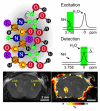The evolution of imaging in cancer: current state and future challenges
- PMID: 21362512
- PMCID: PMC4313866
- DOI: 10.1053/j.seminoncol.2010.11.010
The evolution of imaging in cancer: current state and future challenges
Abstract
Molecular imaging allows for the remote, noninvasive sensing and measurement of cellular and molecular processes in living subjects. Drawing upon a variety of modalities, molecular imaging provides a window into the biology of cancer from the subcellular level to the patient undergoing a new, experimental therapy. As signal transduction cascades and protein interaction networks become clarified, an increasing number of relevant targets for cancer therapy--and imaging--become available. Although conventional imaging is already critical to the management of patients with cancer, molecular imaging will provide even more relevant information, such as early detection of changes with therapy, identification of patient-specific cellular and metabolic abnormalities, and the disposition of therapeutic, gene-tagged cells throughout the body--all of which will have a considerable impact on morbidity and mortality. This overview discusses molecular imaging in oncology, providing examples from a variety of modalities, with an emphasis on emerging techniques for translational imaging.
Copyright © 2011 Elsevier Inc. All rights reserved.
Figures




Similar articles
-
Molecular imaging agents: impact on diagnosis and therapeutics in oncology.Expert Rev Mol Med. 2010 Jul 15;12:e20. doi: 10.1017/S1462399410001511. Expert Rev Mol Med. 2010. PMID: 20633310 Free PMC article. Review.
-
From molecular imaging in preclinical/clinical oncology to theranostic applications in targeted tumor therapy.Eur Rev Med Pharmacol Sci. 2012 Dec;16(14):1925-33. Eur Rev Med Pharmacol Sci. 2012. PMID: 23242718 Review.
-
Optimising translational oncology in clinical practice: strategies to accelerate progress in drug development.Cancer Treat Rev. 2015 Feb;41(2):129-35. doi: 10.1016/j.ctrv.2014.12.004. Epub 2014 Dec 16. Cancer Treat Rev. 2015. PMID: 25533737 Review.
-
Application of molecular imaging technologies in antitumor drug development and therapy.Curr Pharm Des. 2015;21(16):2136-46. doi: 10.2174/1381612821666150109122915. Curr Pharm Des. 2015. PMID: 25578891 Review.
-
Imaging preclinical tumour models: improving translational power.Nat Rev Cancer. 2014 Jul;14(7):481-93. doi: 10.1038/nrc3751. Epub 2014 Jun 19. Nat Rev Cancer. 2014. PMID: 24943811 Review.
Cited by
-
Noninvasive molecular imaging of tuberculosis-associated inflammation with radioiodinated DPA-713.J Infect Dis. 2013 Dec 15;208(12):2067-74. doi: 10.1093/infdis/jit331. Epub 2013 Jul 30. J Infect Dis. 2013. PMID: 23901092 Free PMC article.
-
Proapoptotic Bcl-2 inhibitor as host directed therapy for pulmonary tuberculosis.Res Sq [Preprint]. 2024 Sep 2:rs.3.rs-4926508. doi: 10.21203/rs.3.rs-4926508/v1. Res Sq. 2024. Update in: Nat Commun. 2025 Mar 27;16(1):3003. doi: 10.1038/s41467-025-58190-x. PMID: 39281866 Free PMC article. Updated. Preprint.
-
Visualizing the dynamics of tuberculosis pathology using molecular imaging.J Clin Invest. 2021 Mar 1;131(5):e145107. doi: 10.1172/JCI145107. J Clin Invest. 2021. PMID: 33645551 Free PMC article. Review.
-
GCPII imaging and cancer.Curr Med Chem. 2012;19(9):1346-59. doi: 10.2174/092986712799462612. Curr Med Chem. 2012. PMID: 22304713 Free PMC article. Review.
-
Understanding User Acceptance of Clinical Decision Support Systems to Promote Increased Cancer Screening Rates in a Primary Care Practice.J Prim Care Community Health. 2020 Jan-Dec;11:2150132720958832. doi: 10.1177/2150132720958832. J Prim Care Community Health. 2020. PMID: 33016170 Free PMC article.
References
-
- Patterson DM, Padhani AR, Collins DJ. Technology insight: water diffusion MRI—a potential new biomarker of response to cancer therapy. Nat Clin Pract Oncol. 2008;5:220–33. - PubMed
-
- Kwee TC, Takahara T, Klomp DW, Luijten PR. Cancer imaging: novel concepts in clinical magnetic resonance imaging. J Intern Med. 2010;268:120–32. - PubMed
-
- Kovacs A, Toth L, Glavak C, et al. Integrating functional MRI information into radiotherapy planning of CNS tumors—early experiences. Pathol Oncol Res. Epub ahead of print 2010 September 17. - PubMed
Publication types
MeSH terms
Substances
Grants and funding
LinkOut - more resources
Full Text Sources
Other Literature Sources
Research Materials

